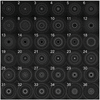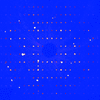issue contents
December 2021 issue

Cover illustration: Some aspects of structure analysis. The introduction of an antiphase boundary leads to a disturbance in the spin structure of iron oxide nanoparticles [Köhler et al. (2021). J. Appl. Cryst. 54, 1719–1729]; the ISOTILT software facilitates discovering cooperative rigid-unit rotations in networks of interconnected rigid units [Campbell et al. (2021). J. Appl. Cryst. 54, 1664–1675, 1847–1856]; and a structural investigation of Ce-exchange capacity of zeolite L allows determination of the mechanisms involved [Confalonieri et al. (2021). J. Appl. Cryst. 54, 1766–1774].
research papers
Open  access
access
 access
accessA method for subtracting the pairwise correlations of a pressure-transmitting medium from neutron pair distribution functions obtained under hydrostatic compression is presented and applied to Ni, MgO and α-quartz.
A formalism is presented for simulating dark-field X-ray microscopy images. Using geometrical optics, it allows direct coupling to mechanical models.
A mixture density network (MDN), a neural network method that can make probabilistic predictions, is applied to X-ray reflectivity data analysis. The probability distribution of several possible parameters obtained using an MDN can help estimate the confidence interval and solve the inverse problem.
Open  access
access
 access
accessCalculations and desmearing of different multiple scattering effects for the small-angle scattering technique using the software package MuScatt are presented.
The symmetry requirements and restrictions for the existence of chiral crystal structures are analysed.
The relation between the electron density at the bond critical point estimated using the quantum theory of atoms in molecules and the curvature of atomic Hirshfeld surfaces is explored empirically through the curvedness property at particular points on these surfaces.
A general iterative algorithm is proposed, to recover the X-ray diffraction data from a single focal construct geometry image, allowing the focal construct geometry to increase the diffraction intensity while simultaneously preserving the angular resolution.
The electro-optical and gyration parameters of a lead germanate ferroelectric single crystal in the direction perpendicular to the optical axis have been investigated by a high-accuracy polarimetric technique.
Open  access
access
 access
accessA method is presented for the self-consistent description of the variations of unit-cell parameters of crystals with pressure and temperature.
For aqueous solutions in quasi-elastic neutron scattering (QENS) studies, Al alloys with higher Al content, boehmite coating, reduced surface area and reduced concentrations of dissolved oxygen tended to be resistant to corrosion. QENS measurements of the empty sample cells revealed that (1) the profile of the cell fabricated with copper-free Al alloy showed a minor scattering vector dependence and (2) reducing the real surface area of the Al surface effectively suppresses its scattering intensity.
Download citation


Download citation


The single-crystal growth of Gd4Ga2O9 with the optical floating zone technique is reported. Structural information has been obtained through powder X-ray diffraction combined with Rietveld refinement. Magnetic susceptibility and heat capacity measurements suggest an antiferromagnetic phase transition and strong magnetic frustration characteristics.
CCDC reference: 2089717
The structure of copper tellurite glasses has been investigated by neutron diffraction.
Download citation


Download citation


Open  access
access
 access
accessTwo examples of twinning, by metric and reticular merohedry, in uranyl-oxide minerals demonstrate the care that must be taken during structural studies, and not only of such complex materials. This contribution also demonstrates the possibilities of the Jana2020 program in revealing twinning and in subsequent refinement.
The linear-algebraic approach to finding cooperative rigid-unit modes in interconnected networks has been greatly improved.
An approach for optimizing the measurement configuration in X-ray diffraction by maximization of Fisher information is proposed. The developed technique is applied to high-resolution X-ray diffraction measurements and microstructure analysis.
This article describes recent developments on the SWING beamline for biological small-angle X-ray scattering (BioSAXS) experiments.
The X-ray irradiation of gold salt aqueous solutions in the synthesis of gold nanoparticles (AuNPs) in the absence of any reducing agent and stabilizer has been followed by in situ small-angle X-ray scattering. The key parameters to obtain stable, monodispersed, bare AuNPs and the influence of the pH of the chemical solution on the final particles were studied.
Open  access
access
 access
accessAntiphase boundaries (APBs) in iron oxide nanoparticles are studied by means of simulations. A strong influence on the spin structure is determined with Monte Carlo simulations, while hkl-dependent peak broadening useful for identifying APBs in real samples is found from Debye scattering equation simulations.
Open  access
access
 access
accessAn optimization procedure of an aerodynamic lens injector with variable geometry is presented. The simulation results are validated by performing experiments on gold and sucrose nanoparticles. This work is envisioned to be an important step towards high-resolution single-particle imaging.
A position-sensitive thermal neutron detector module which is based on multi-layer boron-lined tubes has been developed for the CPHS-SANS instrument. Several aspects of the detector module have been evaluated by simulation and experiment.
The paper shows the overall quality of Cr/Be X-ray multilayer mirrors and gives estimated values of roughness and material intermixing separately.
Laser-induced strain propagation in a Ge crystal is studied using time-resolved X-ray diffraction.
Zeolite L was Na- and NH4-exchanged and the resulting samples were characterized by structural and chemical analyses. From the perspective of the possible use of zeolite L for rare earth element recovery (in particular Ce) and to unveil the differences in the affinity for Ce dictated by the presence of different counter-cations, the three samples with LTL framework type were Ce3+-exchanged and fully characterized.
High lipid–detergent crystallization of two model membrane proteins, MhsT and SERCA1a, where the effects of varying lipid/detergent ratio were tested, and the resulting lipid phases and crystals were studied using electron microscopy, providing insights into the crystallization mechanism.
Open  access
access
 access
accessSmall-angle X-ray scattering (SAXS) coupled with computed tomography (CT), denoted SAXS-CT, enables the spatial distribution of the characteristic parameters of nanoscale structures inside samples to be visualized. In this work, a new scheme with Tikhonov regularization was developed to remove the effects of artifacts caused by streak scattering originating from contour regions of the sample.
Open  access
access
 access
accessThis paper reports on high-resolution analysis of residual stress gradients for a laser-hardened surface layer using a combined angle-dispersive X-ray diffraction approach that applies the universal plot method and sin2Ψ evaluation.
Open  access
access
 access
accessA method is introduced to determine lattice parameters using machine learning. Analysis is presented of the impact of experimental conditions on machine learning prediction, and possibilities for automated unit-cell solution are explored.
teaching and education
Open  access
access
 access
accessPeak profile functions in powder diffraction are presented with the support of Mathematica scripts, easily usable by interested readers, to explore the effect of different instrumental and microstructural parameters. Subsequent articles will illustrate the most common aberrations to the measured patterns and then total scattering methods.
Open  access
access
 access
accessA non-technical yet rigorous introduction to small-angle scattering is proposed, through the systematic use of Fresnel–Feynman analysis of interference phenomena.
short communications
It is pointed out that ab initio indexing of electron backscatter diffraction (EBSD) patterns belongs to the field of indexing single-crystal diffraction data, and the problem can be solved on the same principles as indexing of patterns of other types. It is shown that EBSD-based data can be indexed by programs designed for X-ray data.
computer programs
Open  access
access
 access
accessISOTILT is a user-friendly web-based software package for discovering the cooperative rigid-unit modes in materials whose structures contain interconnected networks of rigid units.
Open  access
access
 access
accessA new software package (anaklasis) for model-based analysis of specular neutron and X-ray reflectivity is introduced. Key features include a user-friendly compact interfacial model definition scheme and a complete set of methods for co-refining data and estimating parameter uncertainty.
Open  access
access
 access
accessA user-friendly Python-based program has been developed to analyze diffuse scattering from single crystals with the reverse Monte Carlo method. The approach allows for refinement of correlated disorder from atomistic supercells with magnetic or structural (occupational and/or displacive) disorder.
This article is an overview of the pyRS software package, used for the reduction and analysis of data measured at the residual stress mapping instrument at Oak Ridge National Laboratory's High Flux Isotope Reactor.
A MATLAB script is offered for the reduction of general higher-rank tensors in terms of independent components.
addenda and errata
Open  access
access
 access
access
 journal menu
journal menu























































